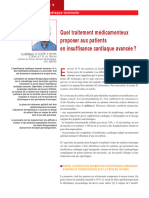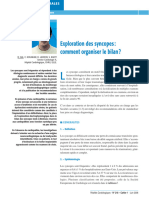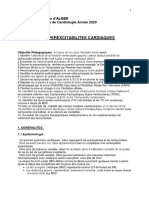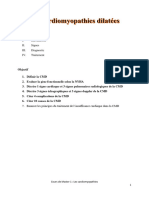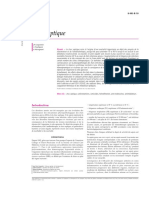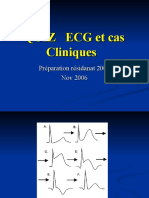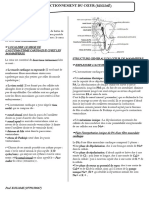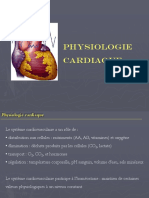Orage Rythmique Chez Un Patient Porteur D'une Cardiomyopathie
Orage Rythmique Chez Un Patient Porteur D'une Cardiomyopathie
Transféré par
souleumanesall84Droits d'auteur :
Formats disponibles
Orage Rythmique Chez Un Patient Porteur D'une Cardiomyopathie
Orage Rythmique Chez Un Patient Porteur D'une Cardiomyopathie
Transféré par
souleumanesall84Titre original
Copyright
Formats disponibles
Partager ce document
Partager ou intégrer le document
Avez-vous trouvé ce document utile ?
Ce contenu est-il inapproprié ?
Droits d'auteur :
Formats disponibles
Orage Rythmique Chez Un Patient Porteur D'une Cardiomyopathie
Orage Rythmique Chez Un Patient Porteur D'une Cardiomyopathie
Transféré par
souleumanesall84Droits d'auteur :
Formats disponibles
Open Access
Case report
Orage rythmique chez un patient porteur d’une cardiomyopathie
dilatée et un défibrillateur automatique implantable (DAI)
Severe ventricular arrhythmias in a patient with dilated cardiomyopathy and
automated implantable defibrillator (AID)
Stéphane Méo Ikama1,&, Jospin Makani1, Bertrand Ellenga-Mbolla1, Louis Igor Ondze-Kafata1, Thierry Raoul Gombet2, Gisèle
Kimbally-Kaky1
1
Service de Cardiologie, CHU de Brazzaville, Congo, 2Service des Urgences, CHU de Brazzaville, Congo
&
Corresponding author: Stéphane Méo Ikama, Service de Cardiologie, CHU de Brazzaville, Congo
Mots clés: Arythmie ventriculaire, cardiomyopathie dilatée, DAI, Congo
Received: 16/03/2017 - Accepted: 27/03/2017 - Published: 11/05/2017
Résumé
Les arythmies ventriculaires graves sont fréquentes au cours de l’insuffisance cardiaque, mettant en jeu le pronostic vital du fait du risque accru de
mort subite. Leur prise en charge efficace reste limitée en Afrique Subsaharienne, du fait des moyens limités ou non disponibles comme le
défibrillateur automatique implantable (DAI). Nous rapportons l’observation d’un patient de 56 ans, porteur d’une cardiomyopathie dilatée non
ischémique à fraction d’éjection du ventricule gauche (FEVG) très abaissée, et qui a bénéficié en 2012 de l’implantation d’un DAI en prévention
primaire de mort subite pour des arythmies ventriculaires. Le traitement d’entretien associait un diurétique, un IEC, et un anti-vitamine K. Le
patient a présenté au mois de novembre 2014 des épisodes itératifs de décharges électriques délivrées par le DAI, sans sensation de palpitations
suggestives d’épisodes d’arythmies. L’examen clinique est pauvre, en particulier pas de signes d’insuffisance cardiaque. L’interrogation du DAI a
objectivé de nombreux épisodes de tachycardie et fibrillation ventriculaires ayant justifié le traitement par ATP ou par chocs de 15 joules. Le
patient est mis sous amiodarone et bêtabloquant. L’évolution a été favorable avec un recul de trois mois, marquée par la reprise d’une vie
normale, sans nouvel épisode de choc. Les anti-arythmiques gardent une importance capitale en cas d’arythmies ventriculaires graves, même en
présence d’un DAI.
Pan African Medical Journal. 2017; 27:31 doi:10.11604/pamj.2017.27.31.12274
This article is available online at: http://www.panafrican-med-journal.com/content/article/27/31/full/
© Stéphane Méo Ikama et al. The Pan African Medical Journal - ISSN 1937-8688. This is an Open Access article distributed under the terms of the Creative Commons
Attribution License (http://creativecommons.org/licenses/by/2.0), which permits unrestricted use, distribution, and reproduction in any medium, provided the original
work is properly cited.
Pan African Medical Journal – ISSN: 1937- 8688 (www.panafrican-med-journal.com)
Published in partnership with the African Field Epidemiology Network (AFENET). (www.afenet.net)
Page number not for citation purposes 1
Abstract
Severe ventricular arrhythmias are frequent during heart failure; they are a life-threatening condition due to the increased risk of sudden death.
Efficient management remains limited in sub-Saharan Africa because of the limited or unavailable medical resources as automated implantable
defibrillator (AID). We report the case of a 56-year old patient with non ischemic dilated cardiomyopathy with very low left ventricular ejection
fraction (LVEF)who underwent AID implantation for primary prevention of sudden cardiac death due to ventricular arrhythmias in 2012.
Maintenance therapy combined diuretic, angiotensin-converting enzyme (ACE) inhibitor and anti-vitamin K. In the month of November 2014 the
patient had iterative episodes requiring the delivery of electric shocks by the AID, without the sensation of palpitations suggestive of episodes of
arrhythmias. Clinical examination is a poor screening test, especially for heart failure. AID detected multiple episodes of tachycardia and ventricular
fibrillation justifying antitachycardia pacing (ATP) therapy or the delivery of electric shocks of 15J. The patient was treated with amiodarone and
beta blocker. Evolution was favorable at 3-months follow-up. The patients had resumed normal activities, without experiencing new episodes
requiring the delivery of electric shocks. This study emphasizes the essential role of anti-arrhythmic drug therapy for severe ventricular
arrhythmias, even in the presence of AID.
Key words: Ventricular arrhythmia, dilated cardiomyopathy, AID, Congo
Introduction urgence, l’adjonction d’un traitement anti-arythmique a été initiée,
associant de l’amiodarone per os à la dose de charge, et un
bêtabloquant. L’échocardiographie transthoracique a mis en
Les arythmies ventriculaires graves sont fréquentes au cours de
évidence un aspect de CMD hypokinétique avec altération de la
l’insuffisance cardiaque, mettant en jeu le pronostic vital du fait du
fonction systolique du VG (FE = 30%). Le Holter ECG des 24 heures
risque accru de mort subite [1, 2]. La prévention de la mort subite
(Figure 2) a objectivé de nombreuses extrasystoles ventriculaires,
d’origine rythmique chez ces patients constitue un challenge en
parfois bigéminées, avec un épisode de tachycardie ventriculaire
Cardiologie [3]. La prise en charge efficace de ces arythmies reste
soutenue, ayant nécessité un choc signalé par la patient. L’évolution
difficile en Afrique Subsaharienne, du fait d’une part des moyens
à H24 était assez favorable, le patient décrivant un léger mieux,
limités ou non disponibles comme le défibrillateur automatique
avec une première nuit calme depuis plusieurs jours. Nous avions
implantable (DAI), et d’autre part des conditions de vie souvent
recommandé la poursuite du traitement associant furosémide,
modestes des populations. Nous rapportons un cas d’orage
périndopril, amiodarone, nébivolol, et acénocoumarol. Le patient a
rythmique chez un patient porteur d’un DAI.
été revu un mois après, signalant un mieux être et une reprise
d’activités professionnelles. L’interrogation du DAI n’a pas objectivé
d’événements rythmiques récents, et le Holter ECG dans les limites
Patient et observation de la normale. Le traitement en cours a été reconduit et optimisé, la
condition clinique et hémodynamique du patient restant stable avec
Un homme de 56 ans, chauffeur de profession, se présentait à notre un recul de trois mois.
consultation pour avis cardiologique. Il est connu comme porteur
d’une cardiomyopathie dilaté (CMD) à coronaires saines, avec
fraction d’éjection abaissée, ayant présenté plusieurs épisodes Discussion
d’insuffisance cardiaque. Ce dernier a bénéficié en 2012 de
l’implantation d’un DAI monochambre de marque Saint Jude
La survenue d’arythmies ventriculaires malignes marque un tournant
Médical, pour des arythmies ventriculaires. Depuis un mois
majeur dans l’évolution du patient insuffisant cardiaque, et constitue
(novembre 2014), il signale des épisodes itératifs de décharges
un facteur de mauvais pronostic au cours de la cardiomyopathie
électriques délivrées par le DAI, épisodes inquiétants, angoissants,
dilatée ischémique ou non [1, 2]. L’évaluation et la stratification du
sans sensation de palpitations. Dans ses antécédents, on ne note
risque rythmique représentent une étape capitale dans leur prise en
rien de particulier, et il ne présente aucun facteur de risque
charge afin d’identifier les stratégies de prévention de la mort subite
cardiovasculaire. Le traitement d’entretien associe du furosémide
[3]. L’incidence de la mort subite est accrue au cours de la CMD
per os, du périndopril, et de l’acénocoumarol. L’examen clinique du
aussi bien ischémique que non ischémique [2]. La mort subite est
05/12/2015 notait un patient en surpoids (IMC = 29,7 kg/m2),
l’un des modes de décès dans l’insuffisance cardiaque [4], le plus
paucisymptomatique en classe fonctionnelle NYHA I-II, apyrétique.
souvent chez des patients en classe fonctionnelle NYHA II et III, et
La pression artérielle était symétrique à 107/68 mmHg, pour une
sa prévention constitue un challenge en cardiologie, en particulier
fréquence cardiaque à 108 bpm. Les bruits du cœur étaient assez
chez des patients porteurs d’une cardiopathie et dysfonction
réguliers, entrecoupés de quelques extrasystoles, sans signe
systolique ventriculaire gauche, avec ou sans insuffisance cardiaque
d’insuffisance cardiaque. Les pouls périphériques proximaux et
[3]. Deux approches majeures, souvent complémentaires, sont
distaux étaient présents et symétriques. L’auscultation
recommandées pour cette prévention: l’approche médicamenteuse,
pleuropulmonaire était normale.
basée sur l’utilisation des antiarythmiques (amiodarone, avec ou
sans bêtabloquant), et l’approche instrumentale basée sur
L’électrocardiogramme de repos s’inscrivait en rythme sinusale, FC
l’implantation d’un défibrillateur automatique implantable (DAI) [3-
= 111 cpm, aspect de bloc incomplet gauche, avec des
6].
extrasystoles ventriculaires isolées. L’interrogation du DAI par un
programmateur MERLIN (Figure 1) a objectivé 12 épisodes
Concernant les antitarythmiques, ceux de la classe III de la
d’arythmies ventriculaires à type de tachycardie et de fibrillation
classification de Vaughan Williams (amiodarone, sotalol, dofétilide,
ventriculaires, ayant nécessité des traitements par ATP
azimilide) sont particulièrement recommandés car ils ont des effets
(antitachycardiapacing) et par des chocs de 15 joules. Devant cette
bénéfiques sur les fréquents chocs induits par les DAI chez des
Page number not for citation purposes 2
patients qui en sont porteurs [7,8], tel était le cas de notre patient.
Aussi, les antiarythmiquessont considérés comme nécessaires chez
plus de 70% des patients porteurs de DAI pour plusieurs raisons Conflits d’intérêts
[7]: ils permettent de prévenir et traiter les épisodes de
tachyarythmies atriales (la fibrillation atriale étant l’arythmie la plus
Les auteurs ne déclarent aucun conflit d'intérêt.
fréquente, survenant chez plus de 20% de patients porteurs d’un
DAI) [7]; les antiarythmiques contribuent à diminuer la fréquence
des chocs des DAI; enfin, ils permettent de juguler les arythmies
ventriculaires résultant des traitements par stimulation Contributions des auteurs
antitachycardique (ATP) délivrés par les DAI.
Tous les auteurs ont lu et approuvé la version finale du manuscrit.
Le DAI peut être recommandé aussi bien en prévention primaire
que secondaire. D’après les recommandations de la Société
Européenne de Cardiologie (ESC) de 2008et 2010 [9,10], le DAI est Figures
recommandé en prévention secondaire chez les patients ayant
survécu à une fibrillation ventriculaire ainsi que chez les patients
ayant des tachycardies ventriculaires hémodynamiquement mal Figure 1: Rapport d’interrogation du DAI objectivant plusieurs
tolérées et/ou des tachycardies ventriculaires syncopales épisodes d’arythmies ventriculaires (tachycardie et fibrillation
documentées, une fraction d’éjection du ventricule gauche ventriculaires) et les traitements délivrés sous forme d’ATP ou de
(FEVG)≤40%, sous traitement médical optimal et dont l’espérance chocs de 15 joules
de vie en bon état fonctionnel est supérieure à un an [9]. Le DAI est Figure 2: Holter ECG des 24h, mettant en évidence des troubles
recommandé en prévention primaire pour réduire la mortalité chez d’excitabilité ventriculaires et un épisode de tachycardie ventriculaire
les patients présentant une dysfonction ventriculaire gauche due à soutenue
un antécédent d’infarctus du myocarde (IDM), au moins 40 jours
après l’IDM, avec une FEVG≤35%, en classe fonctionnelle NYHA II
ou III, sous traitement médical optimal, et dont l’espérance de vie Références
en bon état fonctionnel est supérieure à un an [9]. Enfin, le DAI est
recommandé en prévention primaire pour réduire la mortalité chez 1. Ansalone G, Giannantoni P, Santini M. The stratification and
les patients porteurs d’une myocardiopathie non ischémique avec prevention of the arrhythmia risk in nonischemic dilated
une FEVG≤35%, en classe fonctionnelle NYHA II ou III, sous cardiomyopathy. G Ital Cardiol. 1998; 28(11): 1288-
traitement médical optimal, et dont l’espérance de vie en bon état 302. PubMed | Google Scholar
fonctionnel est supérieure à un an [9], tel était le cas de notre
patient. 2. Lacoviello M, Monitillo F. Non-invasive evaluation of arrhythmic
risk in dilated cardiomyopathy: from imaging to
Par ailleurs, les bénéfices du DAI en prévention primaire ou electrocardiographic measures. Wolrd J Cardiol. 2014; 6(7):
secondaire sont sous-tendus par plusieurs grandes études [11-19]. 562-76. PubMed | Google Scholar
En prévention secondaire [11], le DAI a permis une réduction
notable de la mortalité aussi bien globale (-28%) que rythmique (- 3. Klein H, Auricchio A, Reek S, Geller C. New primary prevention
50%), chez des patients porteurs d’une cardiomyopathie ischémique trials of sudden cardiac death in patients with left ventricular
ou non, avec un bénéfice considérable chez ceux ayant une dysfunction: SCD-Heft and MADIT-II. Am J Cardiol. 1999;
dysfonction systolique sévère (FEVG ≤ 35%). En prévention 83(5B): 91D-97D. PubMed | Google Scholar
primaire, si le bénéfice a été net dans les cardiomyopathies
ischémiques (MADIT, MUSTT, MADIT II, DINAMIT) [12-15], les 4. MERIT-HF Investigators. Effect of metoprolol CR/XL in chronic
premiers essais n’ont pas été bénéfiques dans les cardiomyopathies heart failure: Metoprolol CR/XL Randomized Intervention Trial
non ischémiques (CAT, AMIOVIRT, DEFINITE) [16-18]. C’est grâce à in Congestive Heart Failure (MERIT-HF). Lancet. 1999 Jun 12;
l’étude SCD-HeFT [19] que le bénéfice du DAI en prévention 353(9169): 2001-7. PubMed | Google Scholar
primaire dans les cardiomyopathies non ischémiques a été évident,
avec une réduction du taux de mortalité de l’ordre de -23%. Pour 5. ACC/AHA/ESC 2006 guidelines for management of patients
notre patient, en l’absence du DAI, le décès par mort subite aurait with ventricular arrhythmias and the prevention of sudden
été la modalité évolutive de sa CMD non ischémique. cardiac death: A report of the American College of
Cardiology/American Heart Association Task Force and the
European Society of Cardiology Committee for Practice
Conclusion Guidelines (Writing Committee to Develop Guidelines for
Management of Patients with Ventricular Arrhythmias and the
Les arythmies ventriculaires sont fréquentes au cours des Prevention of Sudden Cardiac Death). Developed in
cardiomyopathies dilatées, cause fréquente d’insuffisance cardiaque collaboration with the European Heart Rhythm Association and
en Afrique subsaharienne, et de mauvais pronostic du fait du risque the Heart Rhythm Society. Europace. 2006; 8: 746-
accru de mort subite. Leur prévention par les traitements 837. PubMed | Google Scholar
antiarythmiques et/ou le défibrillateur automatique implantable
(DAI) constitue un challenge en cardiologie. Notre cas clinique met
en exergue la nécessité d’un traitement optimal de l’insuffisance
cardiaque associant diurétiques de l’anse, bloqueurs du système
rénine-angiotensine, bêtabloquants, antagonistes des récepteurs
des minéralocorticoïdes, mais aussi les aintiarythmiques chez des
patients présentant un risque rythmique élevé, porteurs ou non d’un
DAI.
Page number not for citation purposes 3
11. Connoly SJ, Hallstrom AP, Cappato R et al. Meta-analysis of the
6. ACC/AHA/ESC 2006 guidelines for management of patients implantable cardioverter defibrillator secondary prevention
with ventricular arrhythmias and the prevention of sudden trials - AVID, CSAH and CIDS studies.Antiarrhytymicvs
cardiac death-executive summary. A report of the American implantable defibrillator study - Cardiac Arrest Study Hamburg.
College of Cardiology/American Heart Association Task Force Canadian Implantable Defibrillator Study. Eur Heart J. 2000;
and the European Society of Cardiology Committee for Practice 21: 2071-8. PubMed | Google Scholar
Guidelines (Writing Committee to Develop Guidelines for
Management of patients with Ventricular Arrhythmias and the 12. Moss A, Hall J, Cannom D et al. Improved survival with an
Prevention of Sudden Cardiac Death). Developed in implantable defibrillator in patients with cororary disease at
collaboration with the European Heart Rhythm Association and high risk for ventricular arrhythmia - The MADIT trial. N Engl J
the Heart Rhythm Society. Eur Heart J. 2006; 27: 2099- Med. 1996; 335: 1933-40. PubMed | Google Scholar
140. PubMed | Google Scholar
13. Buxton A, Lee K, DiCarlo L et al. Electrophysiologic testing to
7. Bollmann A, Husser D, Cannom DS. Antiarrhythmic drugs in identify patients with coronary artery disease who are at risk
patients with implantable cardioverter-defibrillators. Am J for sudden cardiac death. The MUSTT trial. N Engl J Med.
Cardiovasc Drugs. 2005; 5(6): 371-8. PubMed | Google 2000; 342: 1937-45. PubMed | Google Scholar
Scholar
14. Moss AJ, Zareba W, Hall J et al. Prophylactic implantation of a
8. Karaoguz R, Maydanozcu S, Altun T, Güldal M, Akyürek O, Erol defibrillator in patients with myocardial infarction and reduced
C. Appropriate ICD therapy in patients with idiopathic dilated ejection fraction. N Engl J Med. 2002; 346: 877-
cardiomyopathy: long term follow-up. Int Heart J. 2006; 47(5): 83. PubMed | Google Scholar
763-73. PubMed | Google Scholar
15. Honhloser S, Kuck H, Dorian P et al. Prophylactic use of an
9. ESC Guidelines for the diagnosis and treatment of acute and implantable cardioverter-defibrillator after acute myocardial
chronic heart failure 2008: the Task Force for the Diagnosis infarction. N Engl J Med. 2004; 351: 2481-
and Treatment of Acute and Chronic Heart Failure 2008 of the 8. PubMed | Google Scholar
European Society of Cardiology. Developed in collaboration
with the Heart Failure Association of the ESC (HFA), and 16. Bansch D, Antz M, Boczor S et al. Primary prevention of
endorsed by the European Society of Intensive Care Medicine sudden cardiac death in idiopathic dilated cardiomyopathy.
(ESICM). Eur Heart J. 2008; 29: 2388-42. PubMed | Google Circulation. 2002; 105: 1453-8. PubMed | Google Scholar
Scholar
17. Strickberger S, Hummel J, Bartlett T et al. Amiodarone versus
10. 2010 Focused Update of ESC Guidelines on device therapy in implantable cardioverter-defibrillator: randomized trial in
heart failure. An update of the 2008 ESC Guidelines for the patients with non ischemic dilated cardiomyopathy and
diagnosis and treatment of acute and chronic heart failure and asymptomatic nonsustained ventricular tachycardia-AMIOVIRT.
the 2007 ESC guidelines for cardiac and resynchronization J Am Coll Cardiol. 2003 May 21; 41(10): 1707-
therapy - Developed with the special contribution of the Heart 12. PubMed |Google Scholar
Failure Association and the European Heart Rhythm
Association. Eur Heart J. 2010; 31: 2677- 18. Kadish A, Dyer A, Daubert P et al. Prophylactic defibrillator
87. PubMed |Google Scholar implantation in patients with non ischemic dilated
cardiomyopathy. N Engl J Med. 2004; 350: 2151-
8. PubMed | Google Scholar
19. Bardy GH, Lee KL, Mark DB et al. Sudden Cardiac Death in
Heart Failure Trial (SCD-HeFT) investigators - Amiodarone or
an implantable cardioverter-defibrillator for congestive heart
failure. N Engl J Med. 2005; 352: 225-37. PubMed | Google
Scholar
Page number not for citation purposes 4
Figure 1: Rapport d’interrogation du DAI objectivant plusieurs épisodes d’arythmies ventriculaires (tachycardie et fibrillation
ventriculaires) et les traitements délivrés sous forme d’ATP ou de chocs de 15 joules
Page number not for citation purposes 5
Figure 2: Holter ECG des 24h, mettant en évidence des troubles d’excitabilité ventriculaires et un épisode de tachycardie
ventriculaire soutenue
Page number not for citation purposes 6
Vous aimerez peut-être aussi
- Revue Des Capteurs Et Signaux Utilis S en Polygraphie R - 2020 - M Decine Du SomDocument13 pagesRevue Des Capteurs Et Signaux Utilis S en Polygraphie R - 2020 - M Decine Du SomThéostyphylKabselPas encore d'évaluation
- 02 VO2 Max Pour Les Nuls PDFDocument41 pages02 VO2 Max Pour Les Nuls PDFmehdi.chlif4374Pas encore d'évaluation
- Anatomie de L'appareil Respiratoire PDFDocument6 pagesAnatomie de L'appareil Respiratoire PDFOmari Tahar100% (3)
- La Fibrillation Atriale Non Valvulaire A Propos de 118 Observations Colligées Au CHU de DakarDocument6 pagesLa Fibrillation Atriale Non Valvulaire A Propos de 118 Observations Colligées Au CHU de Dakarsouleumanesall84Pas encore d'évaluation
- Quel Traitement Médicamenteux Proposer Aux Patients en Insuffisance Cardiaque Avancée?Document7 pagesQuel Traitement Médicamenteux Proposer Aux Patients en Insuffisance Cardiaque Avancée?Eli FATSAWOPas encore d'évaluation
- Fibrillation Atriale.2024Document4 pagesFibrillation Atriale.2024C GtPas encore d'évaluation
- La Dysplasie Arythmogène Pertinence Des Examens DiagnostiquesDocument7 pagesLa Dysplasie Arythmogène Pertinence Des Examens DiagnostiquesAHOUANSOUPas encore d'évaluation
- Les Troubles Du Rythme Support de CoursDocument12 pagesLes Troubles Du Rythme Support de Courslinamariem52Pas encore d'évaluation
- Votre Problã© Matioque Infarctus de MyocadeDocument13 pagesVotre Problã© Matioque Infarctus de Myocadeqd7c6zfhr2Pas encore d'évaluation
- État de Choc CardiogéniqueDocument14 pagesÉtat de Choc CardiogéniqueHafid CHERIETPas encore d'évaluation
- 2017.3 - Stimulation Cardiaque Biventriculaire Dans L'insuffisance CardiaqueDocument4 pages2017.3 - Stimulation Cardiaque Biventriculaire Dans L'insuffisance CardiaqueDidier AdodoPas encore d'évaluation
- Accident Ischémique TransitoireDocument4 pagesAccident Ischémique TransitoireDjallal HassaniPas encore d'évaluation
- Stratégie Pratique en Urgence Face À Un AVCDocument10 pagesStratégie Pratique en Urgence Face À Un AVCaissaPas encore d'évaluation
- 51 s2.0 S024602891865635XDocument11 pages51 s2.0 S024602891865635XOTHMANE RAISSPas encore d'évaluation
- AOMI.2024Document5 pagesAOMI.2024FALMATAPas encore d'évaluation
- Troubles Graves Du Rythme Et de La ConductionDocument9 pagesTroubles Graves Du Rythme Et de La Conductionmcdeco2016Pas encore d'évaluation
- Nouveautés Dans Le Traitement Pharmacologique Du Choc CardiogéniqueDocument6 pagesNouveautés Dans Le Traitement Pharmacologique Du Choc CardiogéniqueLahcen BenhaddaPas encore d'évaluation
- 1 s2.0 S1878648012708285 MainDocument8 pages1 s2.0 S1878648012708285 MainSi LaPas encore d'évaluation
- 2130116_18-ESSI-M_Slama-AnalyseTroublesRyhtmeConcentrationDocument6 pages2130116_18-ESSI-M_Slama-AnalyseTroublesRyhtmeConcentrationmoncef jendoubiPas encore d'évaluation
- Anesthesie Du Patient Cardiaque Pour Chirurgie Non CardiaqueDocument29 pagesAnesthesie Du Patient Cardiaque Pour Chirurgie Non Cardiaquegraceb242Pas encore d'évaluation
- RMS 2427 525Document4 pagesRMS 2427 525ouma oumaPas encore d'évaluation
- MIOCARDITEDocument5 pagesMIOCARDITEproduitsqPas encore d'évaluation
- 028 Koudougou IC Et ANEMIE FinalDocument5 pages028 Koudougou IC Et ANEMIE Finalmutruc.victoria96Pas encore d'évaluation
- Linsuffisance Cardiaque Aiguë Quelle Prise en Charge InitialeDocument5 pagesLinsuffisance Cardiaque Aiguë Quelle Prise en Charge Initialebenelmouffok samiaPas encore d'évaluation
- Item 232 - Fibrillation AtrialeDocument16 pagesItem 232 - Fibrillation Atrialelena.berthetPas encore d'évaluation
- Etat - de ChocDocument21 pagesEtat - de Chocs.sadatPas encore d'évaluation
- 2017.4 - Prise en Charge de L'insuffisance Cardiaque AiguëDocument9 pages2017.4 - Prise en Charge de L'insuffisance Cardiaque AiguëDidier AdodoPas encore d'évaluation
- FA Réanimatoire PDFDocument21 pagesFA Réanimatoire PDFQuentin KesslerPas encore d'évaluation
- Cardiopathie Ischémique Et Infarctus Chez Le DiabétiqueDocument13 pagesCardiopathie Ischémique Et Infarctus Chez Le DiabétiqueB. SL.Pas encore d'évaluation
- 145-Rééducation des cardiopathiesDocument19 pages145-Rééducation des cardiopathiesmllemansuriPas encore d'évaluation
- Bilan Étiologique Des AVC Ischémiques: Le DossierDocument3 pagesBilan Étiologique Des AVC Ischémiques: Le Dossierbenelmouffok samiaPas encore d'évaluation
- INFARCTUS DU MYOCARDE20020externefinal(1)Document20 pagesINFARCTUS DU MYOCARDE20020externefinal(1)Louiza Ait yalaPas encore d'évaluation
- E-P 54 - CopieDocument1 pageE-P 54 - Copiebrooklynpeace2013Pas encore d'évaluation
- Insuffisance Cardiaque Chronique ArceDocument13 pagesInsuffisance Cardiaque Chronique Arcehamidbay313Pas encore d'évaluation
- Dysplasie Arythmogene de Ventricule Droit Revelee Par Une Tachycardie Ventriculaire Chez Un Sujet JeuneDocument6 pagesDysplasie Arythmogene de Ventricule Droit Revelee Par Une Tachycardie Ventriculaire Chez Un Sujet JeuneIJAR JOURNALPas encore d'évaluation
- 1703-Choc Cardiogenique SevereDocument12 pages1703-Choc Cardiogenique SeverekamkermaPas encore d'évaluation
- Congenitaux Adule SmailDocument10 pagesCongenitaux Adule Smailalex mihneaPas encore d'évaluation
- RÉSUMÉDocument1 pageRÉSUMÉHarmony KabashPas encore d'évaluation
- CasgrossesseDocument3 pagesCasgrossesseHadiya MaigaPas encore d'évaluation
- CAT Devant Un ST +Document42 pagesCAT Devant Un ST +Kamal MarzoukiPas encore d'évaluation
- FICHE READAPTATION CARDIAQUEDocument6 pagesFICHE READAPTATION CARDIAQUEThéostyphylKabselPas encore d'évaluation
- Fibrillation Atriale Prise en Charge Peri Operatoire Et Consequences 31 Philip 1442329037Document23 pagesFibrillation Atriale Prise en Charge Peri Operatoire Et Consequences 31 Philip 1442329037Rihab ArbiPas encore d'évaluation
- Prise en Charge de L Embolie PulmonaireDocument8 pagesPrise en Charge de L Embolie PulmonaireAlain SoucotPas encore d'évaluation
- Exploration des syncopes: comment organiser le bilan?: 씰 Médecine interneDocument7 pagesExploration des syncopes: comment organiser le bilan?: 씰 Médecine internecharlyPas encore d'évaluation
- CoursDocument10 pagesCoursfadelmalakisp21Pas encore d'évaluation
- 9 - Insuffisance CardiaqueDocument94 pages9 - Insuffisance CardiaqueFatimaPas encore d'évaluation
- Pages de Ecn+ Cardio-IntDocument16 pagesPages de Ecn+ Cardio-IntHakimdz HakimPas encore d'évaluation
- RMS idPAS D ISBN Pu2009-20s Sa07 Art07Document9 pagesRMS idPAS D ISBN Pu2009-20s Sa07 Art07Gabrielle RizziPas encore d'évaluation
- SHC Aux Urgences AvcDocument5 pagesSHC Aux Urgences Avcabdelkader.gr59Pas encore d'évaluation
- Syndrome Coronarien Aigu ST+ (Infarctus Du Myocarde)Document9 pagesSyndrome Coronarien Aigu ST+ (Infarctus Du Myocarde)Mahefa Serge RakotozafyPas encore d'évaluation
- Troubles Du Rythme CardiaqueDocument6 pagesTroubles Du Rythme CardiaqueLgyjkPas encore d'évaluation
- 00 917Document9 pages00 917hizballah27Pas encore d'évaluation
- 1 - CAT Devant Un CardiopatheDocument12 pages1 - CAT Devant Un CardiopatheAymn KmlPas encore d'évaluation
- 1 s2.0 S1261694X2200164X MainDocument5 pages1 s2.0 S1261694X2200164X MainAllal SalimPas encore d'évaluation
- 03 Herz 02-18 IRMcard PDFDocument4 pages03 Herz 02-18 IRMcard PDFsweet girlPas encore d'évaluation
- État de Choc CardiogéniqueDocument10 pagesÉtat de Choc CardiogéniqueBouch BousmPas encore d'évaluation
- Ref 2 FRDocument11 pagesRef 2 FReyahorry5Pas encore d'évaluation
- Troubles de L - Excitabilité (Pr. Chentir) PDFDocument13 pagesTroubles de L - Excitabilité (Pr. Chentir) PDFDoctor DoctorPas encore d'évaluation
- Les Cardiomyopathies 2022 OkDocument14 pagesLes Cardiomyopathies 2022 OkChiaki ŌtsutsukiPas encore d'évaluation
- Les Cardiomyopathies DilatéesDocument12 pagesLes Cardiomyopathies DilatéesYoussouf OuedraogoPas encore d'évaluation
- Mlavillonniere,+13546 2010 Article 30Document8 pagesMlavillonniere,+13546 2010 Article 30OuSsman RexPas encore d'évaluation
- Quand Penser: À Une Cardiomyopathie Restrictive ?Document3 pagesQuand Penser: À Une Cardiomyopathie Restrictive ?Eli FATSAWOPas encore d'évaluation
- Les Troubles du Rythme Cardiaque : Comprendre, Diagnostiquer et TraiterD'EverandLes Troubles du Rythme Cardiaque : Comprendre, Diagnostiquer et TraiterPas encore d'évaluation
- M20113158Document58 pagesM20113158souleumanesall84Pas encore d'évaluation
- these103-12Document137 pagesthese103-12souleumanesall84Pas encore d'évaluation
- Intramedullary Nailing For Femur Fracture Web Version FrenchDocument6 pagesIntramedullary Nailing For Femur Fracture Web Version Frenchsouleumanesall84Pas encore d'évaluation
- Vanderlindena Mai22 PDFDocument7 pagesVanderlindena Mai22 PDFsouleumanesall84Pas encore d'évaluation
- Fractures Diaphyse Femorale Guide Pratique Traumatologie BarsottiDocument7 pagesFractures Diaphyse Femorale Guide Pratique Traumatologie Barsottisouleumanesall84Pas encore d'évaluation
- Methodologie Ans 510Document9 pagesMethodologie Ans 510souleumanesall84Pas encore d'évaluation
- Facteurs de Risque Cardiovasculaire Et Donnã©es électrocardiographiquesDocument6 pagesFacteurs de Risque Cardiovasculaire Et Donnã©es électrocardiographiquessouleumanesall84Pas encore d'évaluation
- These - Réadaptation Cardiaque - Bilan D'activités À Huit Mois de La Premiere ExperienceDocument175 pagesThese - Réadaptation Cardiaque - Bilan D'activités À Huit Mois de La Premiere Experiencesouleumanesall84Pas encore d'évaluation
- Evaluation de La Prise en Charge Des Patients en Readaptation CardiaqueDocument122 pagesEvaluation de La Prise en Charge Des Patients en Readaptation Cardiaquesouleumanesall84Pas encore d'évaluation
- Enregistrement ECG Ambulatoire - Choix de La Technique, Indications Et Politique Actuelle de RemboursementDocument9 pagesEnregistrement ECG Ambulatoire - Choix de La Technique, Indications Et Politique Actuelle de Remboursementsouleumanesall84Pas encore d'évaluation
- Traumatologie Du RachisDocument253 pagesTraumatologie Du Rachissouleumanesall84100% (1)
- La Réadaptation Cardiaque Du Valvulaire opéréDocument173 pagesLa Réadaptation Cardiaque Du Valvulaire opérésouleumanesall84Pas encore d'évaluation
- MémoireDocument26 pagesMémoiresouleumanesall84Pas encore d'évaluation
- Cardioverter-Defibrillators in Hypertrophic Cardiomyopathy - A French Multicenter StudyDocument68 pagesCardioverter-Defibrillators in Hypertrophic Cardiomyopathy - A French Multicenter Studysouleumanesall84Pas encore d'évaluation
- CMR3-Strategie RechercheDocument21 pagesCMR3-Strategie Recherchesouleumanesall84Pas encore d'évaluation
- La Chimie Du Cerveau Les Neurotransmetteurs Et HormonesDocument1 pageLa Chimie Du Cerveau Les Neurotransmetteurs Et HormonesdhuyPas encore d'évaluation
- 1.système EndocrinienDocument31 pages1.système EndocrinienSid ahmed Zerrouki sbaPas encore d'évaluation
- Choc SeptiqueDocument13 pagesChoc SeptiqueNabila KALLAPas encore d'évaluation
- Insuffisance Coronaire Et Infarctus de Myocarde. (4) ECGDocument39 pagesInsuffisance Coronaire Et Infarctus de Myocarde. (4) ECGAhmed Ben MohamedPas encore d'évaluation
- 02 SangDocument3 pages02 Sangabdelouahab berkoukiPas encore d'évaluation
- PGF 3 DR BOUMENDJELDocument29 pagesPGF 3 DR BOUMENDJELAlina Topor Psi-MedicalPas encore d'évaluation
- Influx Nerveux (Cours de Physiologie Generale)Document17 pagesInflux Nerveux (Cours de Physiologie Generale)hyppolitefrantzley374Pas encore d'évaluation
- 3 Cycle Cardiaque Hemodynamique IntracardiaqueDocument54 pages3 Cycle Cardiaque Hemodynamique IntracardiaqueAfdal BiosicaPas encore d'évaluation
- GBM Moulhi PDFDocument199 pagesGBM Moulhi PDFismailPas encore d'évaluation
- Etat de Choc HemamidDocument23 pagesEtat de Choc HemamidMoha Med AnedePas encore d'évaluation
- L'Oedeme Aigu Du Poumon Cardiogenique: Oxygène OxygèneDocument1 pageL'Oedeme Aigu Du Poumon Cardiogenique: Oxygène OxygèneAMINA KHOUDRIAPas encore d'évaluation
- Fiche de TD 1 Sur La Respiration 2024Document3 pagesFiche de TD 1 Sur La Respiration 2024steve fotsoPas encore d'évaluation
- 1 Electrophysiologie Cardiaque 2024 (1)Document38 pages1 Electrophysiologie Cardiaque 2024 (1)ser66691Pas encore d'évaluation
- Lebron Louis Alexandre - Fiche de TestDocument3 pagesLebron Louis Alexandre - Fiche de TestGv. Khoa Pháp Lê Việt HưngPas encore d'évaluation
- Tuyaux Neurobio CorrigãsDocument15 pagesTuyaux Neurobio CorrigãsYwenn SAMYNPas encore d'évaluation
- 1finale Semiologie Troubles Du Rythme Oct2007Document95 pages1finale Semiologie Troubles Du Rythme Oct2007Arztin Asma KammounPas encore d'évaluation
- C. Biochimie III. Lipides (III.3. Métabolisme Des TG)Document24 pagesC. Biochimie III. Lipides (III.3. Métabolisme Des TG)Rania HamdiPas encore d'évaluation
- Qe PR KouachDocument6 pagesQe PR Kouachsalma qibaaPas encore d'évaluation
- Resume Fonctionnement Du CoeurDocument4 pagesResume Fonctionnement Du Coeurlatifyattara1Pas encore d'évaluation
- Physiologie CardiaqueDocument92 pagesPhysiologie CardiaqueMeriem Hiba100% (1)
- Fiche AtteintesCardiaquesDocument3 pagesFiche AtteintesCardiaquesMohamed DoudeyPas encore d'évaluation
- COURS HEMATO GENE ABM Dr1Document29 pagesCOURS HEMATO GENE ABM Dr1assikigloirePas encore d'évaluation
- Physio Coeur 5 Oct 1Document5 pagesPhysio Coeur 5 Oct 1Essoulaymani FirdawsPas encore d'évaluation
- PRODUITS SQNGUINS UCcours N°2 PDFDocument21 pagesPRODUITS SQNGUINS UCcours N°2 PDFsoumri omaimaPas encore d'évaluation
- JjiiijjDocument31 pagesJjiiijjFaith CyrilPas encore d'évaluation
- CIVDDocument34 pagesCIVDMêdéssè Mireille DANHOUEGNONPas encore d'évaluation
- Exercices Corrigés de ThermorégulationDocument5 pagesExercices Corrigés de ThermorégulationAbdoulaye SenouPas encore d'évaluation




